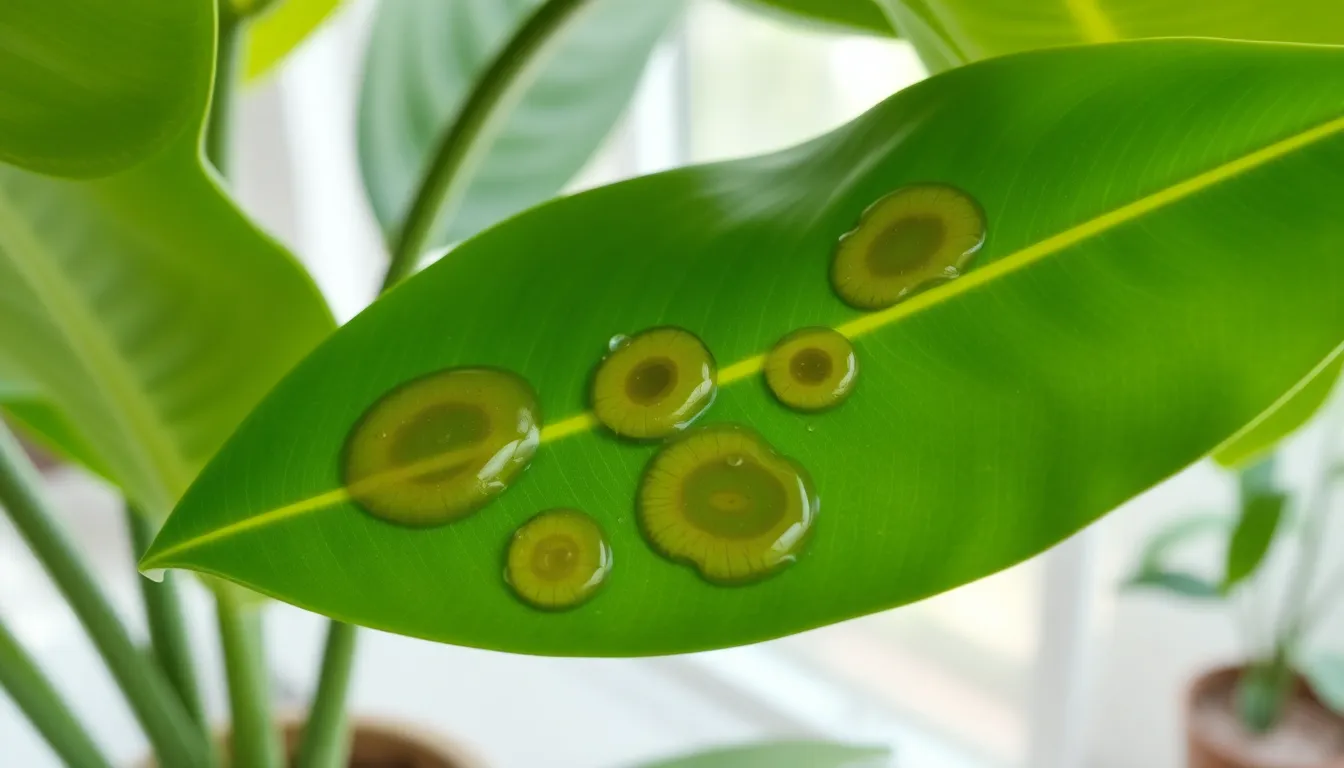
Leaf Spot Rubber Plant Diseases: Cure Your Plants and Restore Their Beauty
Rubber plants are the rock stars of indoor greenery, bringing a touch of elegance to any space. But just like any celebrity, they can face their fair share of drama—enter leaf spot diseases. These pesky spots can turn a thriving rubber plant into a sad spectacle faster than you can say “photosynthesis.”
Leaf Spot Rubber Plant Diseases
Leaf spot diseases significantly affect rubber plants, leading to unsightly foliage and compromised health. Various pathogens, including fungi and bacteria, cause these diseases, manifesting as dark or discolored spots on leaves.
Fungal infections, such as Cercospora and Anthracnose, often lead to rapid development of leaf spots. Symptoms typically include necrotic patches, which may expand and result in leaf drop. Barriers like proper air circulation and reducing humidity minimize the risk of these fungi.
Bacterial pathogens, like Xanthomonas, also cause leaf spots, presenting as yellowish halos around dark centers. Increased moisture and improper watering create favorable conditions for bacterial growth. Implementing a consistent watering schedule helps prevent these issues.
Different environmental factors contribute to the severity of leaf spot diseases. Excess sunlight and poor drainage conditions exacerbate the impact on rubber plants. Monitoring light levels and ensuring well-draining soil are crucial for maintaining plant health.
Preventative measures, such as routine inspection of leaves and prompt removal of infected ones, help in early detection and control. Applying appropriate fungicides or bactericides can offer additional protection when necessary.
Recognizing leaf spot diseases early allows for proper intervention, preserving the aesthetic appeal of rubber plants in indoor spaces. Consistent care and attention make a significant difference in preventing these common plant ailments.
Common Types of Leaf Spot Diseases


Rubber plants may encounter various leaf spot diseases, significantly affecting their health and attractiveness. Understanding these common types helps in identifying and managing issues effectively.
Bacterial Leaf Spot
Bacterial leaf spot primarily occurs due to pathogens like Xanthomonas. Symptoms include water-soaked lesions that develop into yellow halos surrounding dark centers. High humidity and overwatering can enhance the spread of these bacteria. Effective management requires removing affected leaves and ensuring proper air circulation. Employing a balanced watering routine can help prevent recurrence.
Fungal Leaf Spot
Fungal leaf spots often manifest as dark spots or necrotic patches on the leaves, commonly caused by fungi such as Cercospora and Anthracnose. Environments with excessive moisture and poor drainage create ideal conditions for these fungi. Regularly inspecting and watering the rubber plant appropriately can limit the growth of fungi. Infected leaves should be pruned to restore the plant’s health and prevent further damage.
Symptoms and Identification
Recognizing leaf spot diseases early enhances the chances of recovery for rubber plants. Identifying these symptoms helps address issues before they escalate into severe problems.
Early Signs of Infection
Water-soaked lesions often appear first, indicating the presence of bacterial leaf spot. Yellow halos surrounding these lesions signify a buildup of pathogens. Dark spots may develop among the leaf veins, marking the onset of fungal infections like Cercospora. Leaf drooping or wilting can accompany these symptoms, signaling stress. Maintaining a watchful eye on changes fosters prompt management of infections.
Advanced Symptoms
As infections progress, affected leaves show extensive yellowing and browning. Dark patches evolve into necrotic tissue, leading to leaf death. Fungal infections may spread rapidly, resulting in large, unsightly areas on foliage. Leaves may fall prematurely, creating gaps in the plant’s appearance. Infected plants may exhibit stunted growth due to energy lost in fighting disease. Tracking these signs allows for timely interventions and better outcomes for the rubber plant’s health.
Causes and Risk Factors
Leaf spot diseases in rubber plants arise from various causes and risk factors. Identifying these threats aids in preventive measures.
Environmental Conditions
Excess sunlight can lead to leaf scorch, creating ideal conditions for fungal infections. High humidity promotes the growth of pathogens such as Cercospora. Poor drainage exacerbates these issues, allowing water to accumulate and causing root rot. A balanced environment contributes to healthier plants. Monitoring light levels and ensuring adequate airflow reduces disease risk significantly.
Nutrient Deficiencies
Nutrient deficiencies impact rubber plant health significantly. A lack of nitrogen results in pale leaves, making them more susceptible to infections. Insufficient potassium weakens the plant’s overall structure, leading to increased vulnerability to diseases. Iron deficiencies can cause chlorosis, affecting photosynthesis and the plant’s resilience. Regular soil testing can detect these deficiencies early, facilitating timely interventions to support robust growth and disease resistance.
Management and Treatment Options
Effective management options exist for leaf spot diseases in rubber plants. These strategies include cultural practices and chemical treatments tailored to combat specific pathogens.
Cultural Practices
Cultural practices cultivate healthier environments for rubber plants. Regularly inspecting plants for early signs of leaf spot diseases helps catch problems before they escalate. It’s essential to provide adequate air circulation around the foliage, reducing humidity levels that foster fungal growth. Adjusting watering habits also contributes significantly; ensuring soil drains well prevents water accumulation that leads to bacterial infections. Furthermore, maintaining nutrient levels through balanced fertilization enhances plant resilience against diseases. Frequent removal of affected leaves keeps the plant healthy and aids in preventing the spread of pathogens.
Chemical Treatments
Chemical treatments offer targeted solutions for managing leaf spot diseases. Applying fungicides can effectively address fungal infections like Cercospora and Anthracnose when used as directed. Selecting a bactericide specifically formulated to combat Xanthomonas protects plants from bacterial leaf spot. Timing is crucial; treating at the first sign of infection improves chances for recovery. It’s vital to follow safety guidelines and application instructions to ensure efficacy and minimize risks. Additionally, rotating chemical treatments helps prevent pathogens from developing resistance, maintaining the overall health of rubber plants.
Conclusion
Maintaining the health of rubber plants requires vigilance and proactive care. Leaf spot diseases can pose significant challenges but recognizing early symptoms and implementing effective management strategies can make a difference. By ensuring proper air circulation and maintaining a balanced watering routine, they can minimize the risk of infection. Regular inspections and soil testing help identify potential nutrient deficiencies, allowing for timely interventions. With the right approach, rubber plants can thrive and continue to enhance indoor spaces with their striking beauty.



